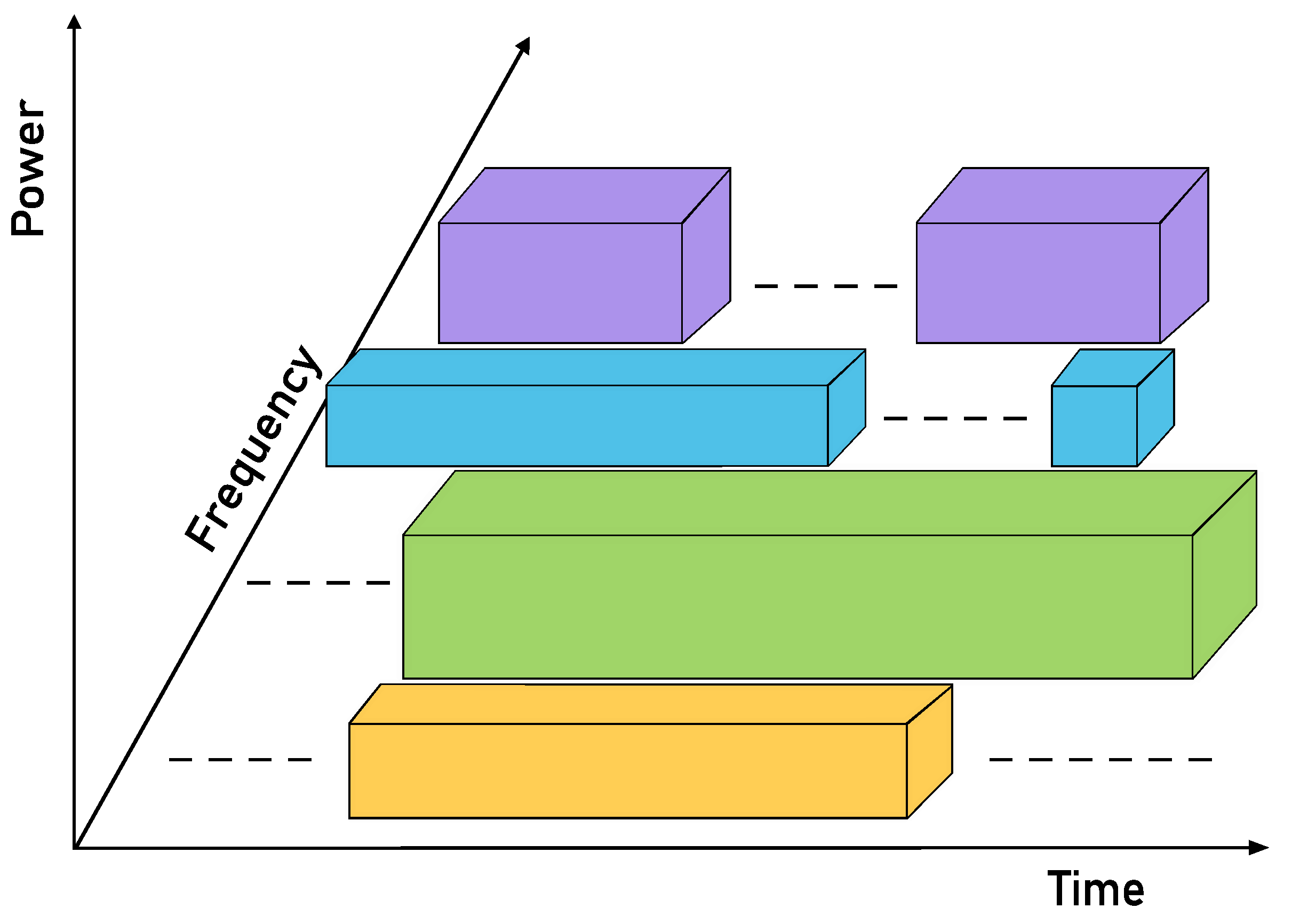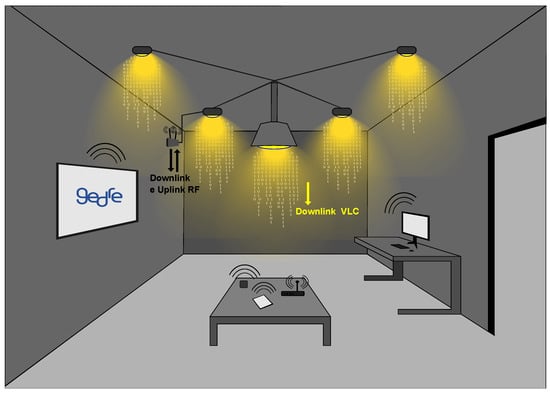
| Version | Summary | Created by | Modification | Content Size | Created at | Operation |
|---|---|---|---|---|---|---|
| 1 | Carlos Henrique Barriquello | -- | 1762 | 2023-09-22 16:33:03 | | | |
| 2 | Catherine Yang | Meta information modification | 1762 | 2023-09-25 02:46:27 | | | | |
| 3 | Catherine Yang | Meta information modification | 1762 | 2023-09-25 02:47:51 | | | | |
| 4 | Catherine Yang | Meta information modification | 1762 | 2023-09-25 02:48:28 | | | | |
| 5 | Catherine Yang | Meta information modification | 1762 | 2023-09-25 02:49:40 | | |
Video Upload Options
Building on the foundations of Cognitive Radio (CR), Visible Light Communication (VLC), and Radio Frequency (RF), this integration of Cognitive Radio Sensor Networks (CRSNs) fuses CR, VLC, and RF technologies with sensor networks. This integration navigates the complexities of dynamic and heterogeneous wireless environments, offering a novel framework to harness the combined potential of these domains. CRSNs leverage the adaptability and intelligence of CR, the high data rates and energy efficiency of VLC, and the ubiquity and range of RF. Sensor nodes in CRSNs, equipped with CR, VLC, and RF capabilities, autonomously sense, analyze, and adapt to the wireless environment. This optimizes spectrum usage, enhances network performance, and facilitates efficient data transmission.
1. Introduction
CR augments wireless communication by adeptly identifying available communication channels and promptly transitioning to vacant ones, thus averting interference with Primary Users (PUs) who possess licensed spectrum rights [1]. This strategy, termed Dynamic Spectrum Access (DSA), permits Secondary Users (SUs) to opportunistically utilize underexploited frequency bands without inducing harmful interference, thereby optimizing the utilization of the RF spectrum. A complementary concept, Dynamic Spectrum Sharing (DSS), entails real-time spectrum sharing among multiple users, encompassing both PUs and SUs. Contrary to DSA, which centers on opportunistic access to underutilized spectrum bands, DSS dynamically allocates the spectrum to various users based on their immediate needs and the spectrum's availability. This mechanism necessitates coordination and collaboration between PUs and SUs to safeguard efficient spectrum utilization while preserving the Quality of Service (QoS) for PUs [2][3].
-
Spectrum resources: The range of electromagnetic frequencies employed for wireless communication is of paramount importance in CRSNs. As the spectrum hosts multiple critical applications, it is tightly regulated. CR is distinctive in its ability to dynamically access and utilize underutilized spectrum segments, known as “white spaces” or “spectrum holes”. The ability to intelligently detect unoccupied communication channels and adapt spectrum usage enables CR to coexist efficiently with other wireless systems.
-
Time resources: Time synchronization is integral to CRSNs, as it facilitates coordination among sensor nodes and optimizes resource allocation. Through precise time alignment, CRSNs mitigate collisions and ensure efficient communication.
-
Power resources: Power management is vital in CRSNs due to the limited energy resources of sensor nodes. By dynamically adjusting transmission power and routing paths, CR optimizes energy consumption, prolongs network lifespan, and enhances energy efficiency.
-
Space resources: CRSNs leverage the spatial characteristics of wireless environments to optimize resource allocation and interference management. The strategic deployment of sensor nodes based on their physical locations aids in maximizing spectrum usage and enhancing network performance.

-
Spectrum sensing: CR devices detect unused or underutilized frequency bands;
-
Spectrum decision: based on sensed spectra, CR devices select the most suitable frequency bands for transmission;
-
Spectrum sharing: spectrum sharing strategies, including underlay, overlay, and hybrid, manage the allocation and sharing of the spectrum between PUs and SUs;
-
Interference mitigation: techniques such as power control mechanisms and adaptive modulation and coding schemes are employed to mitigate interference;
-
Spectrum mobility: CR devices utilize spectrum mobility techniques to efficiently use the available spectrum resources in dynamic spectrum environments;
-
Spectrum management database: a centralized repository of spectrum utilization data which informs about the availability of spectrum resources;
-
Dynamic spectrum Access: allows CR devices to dynamically adapt frequency usage based on real-time conditions and spectrum availability;
-
Spectrum monitoring and enforcement: involves continuous spectrum monitoring to maintain its integrity and ensure fair and efficient use.

2. Performance Metrics
2.1. Fairness
2.2. Outage
2.3. Sum Rate
2.4. Throughput
2.5. QoS
3. Types of Hybrid RF/VLC Systems in CRSNs
Hybrid systems denote the harmonious fusion of two or more distinctive network types. These systems' configuration relies on unique network typologies and respective application use-cases. A hybrid system can function as an uplink, a downlink, or both, depending on the specific requirements [18].

3.1. Dual-Hop Hybrid RF/VLC System
In this topology, the RF and VLC networks are connected through a relay, facilitating dual-hop communication. This setup is particularly useful for scenarios requiring extended coverage.
3.2. Opportunistic Separate Networks (RF/VLC)
Here, the RF and VLC networks operate independently but can switch between each other opportunistically based on environmental conditions or network requirements.
3.3. Heterogeneous Networks (HetNets) with a Centralized Unit
In this configuration, multiple cellular typologies are merged to craft a seamless, high-efficiency network infrastructure. The centralized unit manages resource allocation and network coordination.
References
- Kaur, R.; Buttar, A.S.; Anand, J. Spectrum Sharing Schemes in Cognitive Radio Network: A Survey. In Proceedings of the 2018 Second International Conference on Electronics, Communication and Aerospace Technology (ICECA), Coimbatore, India, 29–31 March 2018; pp. 1279–1284.
- Kumar, A.; Kumar, K. Multiple Access Schemes for Cognitive Radio Networks: A Survey. Phys. Commun. 2020, 38, 100953.
- Naeem, A.; Rehmani, M.H.; Saleem, Y.; Rashid, I.; Crespi, N. Network Coding in Cognitive Radio Networks: A Comprehensive Survey. IEEE Commun. Surv. Tutor. 2017, 19, 1945–1973.
- Ding, J.; I, C.L.; Zhao, K.; Liu, S. Exploring the Effect of Optical Beams on Hybrid VLC/RF Transmission Characteristics. Photonics 2023, 10, 185.
- Liu, J.; Wang, J.; Wang, Q. Secrecy Performance for Hybrid RF/VLC DF Relaying Systems. In Proceedings of the International Conference on Frontiers of Electronics, Information and Computation Technologies, Changsha, China, 21–23 May 2021; pp. 1–5.
- Al-Khori, J.; Nauryzbayev, G.; Abdallah, M.M.; Hamdi, M. Secrecy Performance of Decode-and-Forward Based Hybrid RF/VLC Relaying Systems. IEEE Access 2019, 7, 10844–10856.
- Ahmad, A.; Ahmad, S.; Rehmani, M.H.; Hassan, N.U. A Survey on Radio Resource Allocation in Cognitive Radio Sensor Networks. IEEE Commun. Surv. Tutor. 2015, 17, 888–917.
- Hu, P.; Ibnkahla, M. A Consensus-Based Protocol for Spectrum Sharing Fairness in Cognitive Radio Ad Hoc and Sensor Networks. Int. J. Distrib. Sens. Netw. 2012, 8, 370251.
- Aroua, S.; El Korbi, I.; Ghamri-Doudane, Y.; Saidane, L.A. A Distributed Cooperative Spectrum Resource Allocation in Smart Home Cognitive Wireless Sensor Networks. In Proceedings of the 2017 IEEE Symposium on Computers and Communications (ISCC), Heraklion, Greece, 3–6 July 2017; pp. 754–759.
- Stephan, T.; Suresh Joseph, K. Particle Swarm Optimization-Based Energy Efficient Channel Assignment Technique for Clustered Cognitive Radio Sensor Networks. Comput. J. 2018, 61, 926–936.
- Obeed, M.; Chaaban, A.; Salhab, A.M.; Zummo, S.A.; Alouini, M.S. Physical Layer Security in Cooperative NOMA Hybrid VLC/RF Systems. arXiv 2020, arXiv:2008.10839.
- Han, B.; Zeng, M.; Guo, Q.; Jiang, H.; Zhang, Q.; Feng, L. Energy-Efficient Sensing and Transmission for Multi-Hop Relay Cognitive Radio Sensor Networks. China Commun. 2018, 15, 106–117.
- Kumar, D.; Singya, P.K.; Choi, K.; Bhatia, V. SWIPT Enabled Cooperative Cognitive Radio Sensor Network With Non-Linear Power Amplifier. IEEE Trans. Cogn. Commun. Netw. 2023, 9, 884–896.
- Sarthi, A.; Gurjar, D.S.; Sai, C.; Pattanayak, P.; Bhardwaj, A. Performance Impact of Hardware Impairments on Wireless Powered Cognitive Radio Sensor Networks. IEEE Sens. Lett. 2020, 4, 7500704.
- Abuella, H.; Elamassie, M.; Uysal, M.; Xu, Z.; Serpedin, E.; Qaraqe, K.A.; Ekin, S. Hybrid RF/VLC Systems: A Comprehensive Survey on Network Topologies, Performance Analyses, Applications, and Future Directions. IEEE Access 2021, 9, 160402–160436.
- Zhang, L.; Xin, Y.; Liang, Y.C.; Poor, H. Cognitive Multiple Access Channels: Optimal Power Allocation for Weighted Sum Rate Maximization. IEEE Trans. Commun. 2009, 57, 2754–2762.
- Zheng, L.; Tan, C.W. Maximizing Sum Rates in Cognitive Radio Networks: Convex Relaxation and Global Optimization Algorithms. IEEE J. Sel. Areas Commun. 2014, 32, 667–680.
- Singh, G.; Srivastava, A.; Bohara, V.A.; Noor-A-Rahim, M.; Liu, Z.; Pesch, D. Towards 6G-V2X: Aggregated RF-VLC for Ultra-Reliable and Low-Latency Autonomous Driving Under Meteorological Impact. arXiv 2022, arXiv:2208.06287.
- Ren, J.; Zhang, H.; Hu, H.; Cheng, F.; Qin, Y. Achievable Throughput Analysis and Channel Access in Energy Harvesting Cognitive Radio Sensor Network. IEEE Access 2019, 7, 82277–82287.
- Liu, J.; Wang, J.; Zhang, B.; Wang, Q. Secrecy Performance Analysis of Hybrid RF/VLC Dual-Hop Relaying Systems. Front. Phys. 2021, 9, 683479.
- Shah, G.A.; Alagoz, F.; Fadel, E.A.; Akan, O.B. A Spectrum-Aware Clustering for Efficient Multimedia Routing in Cognitive Radio Sensor Networks. IEEE Trans. Veh. Technol. 2014, 63, 3369–3380.
- Ogbodo, E.U.; Dorrell, D.; Abu-Mahfouz, A.M. Cognitive Radio Based Sensor Network in Smart Grid: Architectures, Applications and Communication Technologies. IEEE Access 2017, 5, 19084–19098.




